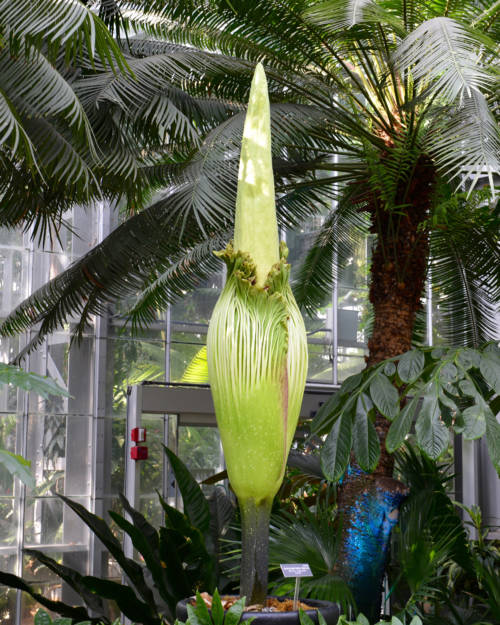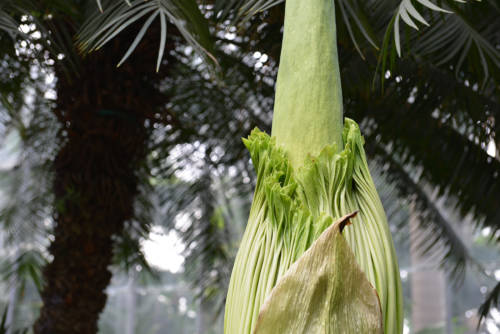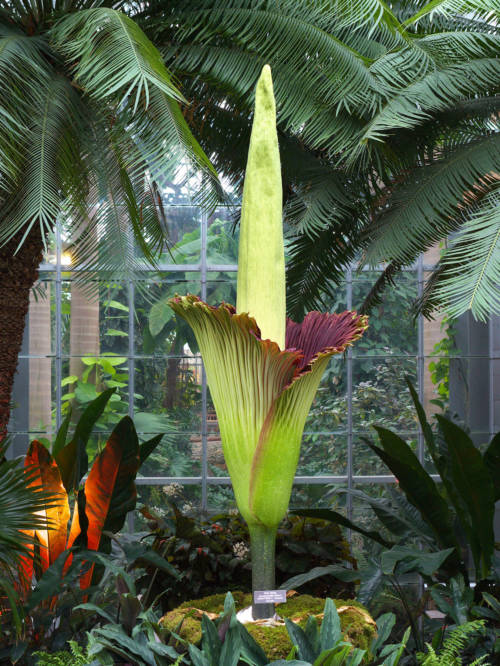
The Corpse Flower, The World’s Largest and Smelliest Flower, Is Mysteriously Blooming Across The U.S.
Earning its name from the stench it emits when in bloom, the corpse flower’s eye-watering waft is aptly described as “rotting meat with a hint of fishy garlic”. But most people don’t know that this smell only lasts for a short-lived six to eight hours. So by the time the night crowds arrived to see the seven-foot tall flower at the United States Botanic Garden in Washington, D.C. on Tuesday evening, it was only giving off subtle hints of spoiled brussel sprouts.
To the surprise of the garden’s chief botanists, this particular corpse flower is the first domesticated plant of its kind to bloom in the morning. Corpse flowers are finicky – they need warm weather and lots of humidity to open up, so they generally don’t bloom until the afternoon when it’s hottest out.
A first time bloomer, this D.C. corpse flower is only six years old and is relatively small compared to its parent plant, which is about three times bigger and has never bloomed before. It’s unusual that this plant could store enough energy to bloom so young, since most take several years (and up to decades) to produce a single flower.
The corpse flower is a proven social media hit, such that even the new Gilmore Girls trailer calls it “the plant that everyone lines up to see even though it smells like dead fish.”
With a handful of corpse flowers blooming this week around the country, botanists are wondering how so many of these seldom-blooming plants opened at the same time. Devin Dotson, public affairs and exhibits specialist at the U.S. Botanic Garden, says that in the last 10 to 20 years there’s been a huge surge in the number of public gardens acquiring corpse flowers for display. These plants likely share a common parent, which could help explain the synchronization.
Since it’s really a guessing game as to when each corpse flower will bloom– and when it does it happens rather quickly– botanists keep a close watch on them in the greenhouse. There’s only about a week and a half between when there’s a recognizable bud and the moment the flower opens.
This stinky plant isn’t a flower in the singular sense. It’s what’s known as an inflorescence, meaning that a corpse flower is made of hundreds of tiny flowers that appear to be one giant flower. As the largest unbranched inflorescence in the world, fully-bloomed corpse flowers are typically taller than the people that come to see them. In the wild the blooms reach up to 12 feet, but domesticated plants are smaller, like this DC bloom, which has reached seven feet and four inches.
As the showpiece of botanic gardens given their huge size and uniquely putrid smell, corpse flowers draw thousands of visitors when they do bloom. Dotson explains it’s one way gardens spur public interest in plants, and jokes that it draws more visitors than Pokémon GO can. The flower is a proven social media hit, such that even the new Gilmore Girls trailer mentions that the corpse flower is “the plant that everyone lines up to see even though it smells like dead fish.”
That social media buzz explains why at 10 p.m. on Tuesday night there’s hundreds of people wrapped around a full city block waiting for their chance to glimpse the sinister looking plant and snap a selfie with it. When a different corpse flower bloomed at the garden in 2013, around 20,000 people came in to take a gander. For those who couldn’t make the bloom in person this year, the U.S. Botanic Garden live-streamed it to thousands of people around the world, as did the New York Botanical Garden, when its flower opened last weekend.
While the common name of the plant stems from its noxious smell, its Latin name, Amorphophallus titanium, is taken from its shape, translating as “giant misshapen penis” because of the size of its spadix, the large vertical center.
But the plant really doesn’t stay erect for long. Around 24 to 48 hours after the peak bloom, the spadix goes completely limp, having expended all its energy emitting smells that work to attract pollinators like carrion beetles and flies, which are common in the forests of its native Indonesia. That smell permeates surrounding areas and can drift up to a mile away.
Scratch-and-sniff lovers around the world can rejoice, since that fleeting rotten smell will soon be bottled. The U.S. Botanic Garden is working with a “master smeller” (yes, such a thing exists) who recorded the flower’s scent notes during its bloom this year, in order to replicate the odor for educational purposes. Some foul-smelling practical jokes are likely to follow, as well.




































